How to Cook Scallops: A Beginners’ Guide
I wrote a post called, All About Scallops, where I explained the different types of scallops, how they are harvested, how to buy them, and how to store them but not cook them. Miss Emerson called me out on this in her comment when she said,
You also present the material in a simple, concise, easy-to-read way. The only information I missed is that I would have liked more written about techniques like how do you get a proper sear, should you season scallops before or after cooking, and how you can tell it is done.
So in response to Miss Emerson, the question is:
How do you cook scallops?
Answer: Quickly
Hear the rim shot? It sounds like a glib answer to a reasonable question. But it is the truth.
The part of the scallop we eat is the strong, lean muscle that opens and closes the scallop’s shell to propel itself through the water. And lean muscle requires quick cooking.
An overcooked scallop has a very chewy texture. That’s because the proteins have cooked to the point that they squeeze out all the moisture. And there is no extra fat present in a scallop to help to mask the fact that they are overcooked.
So, what’s a beginning cook to do when even experienced cooks can end up with over-cooked scallops? Again, the answer is speed.
Also, to play up scallops’ delicate sweetness, it’s best to use dry-heat cooking methods so that the sugars and proteins on the surface can brown through caramelization and the Maillard reactions.
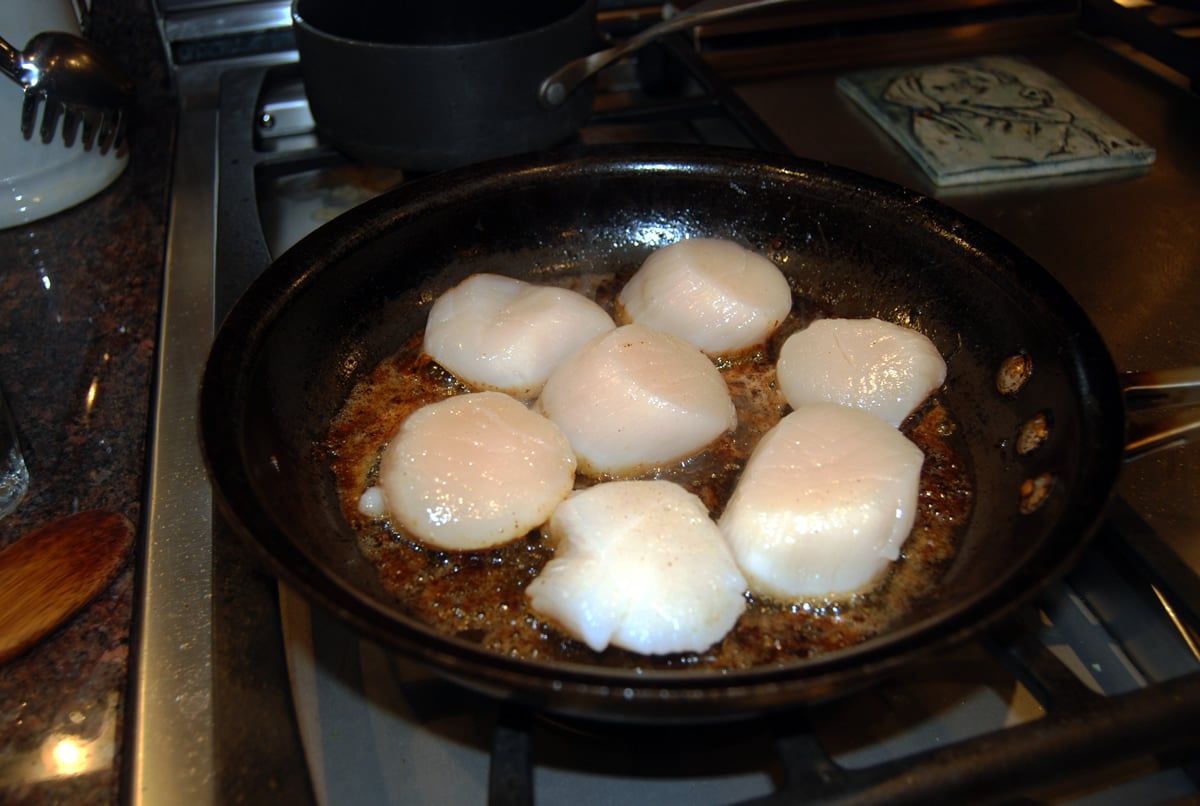
How Do You Know When They Are Done?
Okay, but scallops are small. So, how do you know they’re done? After all, overcooked is terrible. Fortunately, the scallops can show us when they’re done.
As the proteins cook, they turn from translucent to opaque. This is dramatically evident when cooking an egg–the whites turn from clear to white as the egg cooks. The same applies to all proteins, although the darker pigments in other proteins can make the change look less dramatic.
When you cook scallops, please don’t walk away from them. If you are going to sear them, leave them alone. Otherwise, keep them moving, whether for a stir fry or grilling. Watch for the change from translucent to opaque.
To begin with, you might have to cut one open to check for doneness, but once you know how long it takes and what it looks like when it is done, you won’t have to do that anymore.
Because of carryover cooking, taking them off the heat and out of the pan is best when they are not entirely done. In the case of scallops, slightly underdone is preferable to overdone.
How to Get Them Ready To Cook
To prepare the scallops for cooking, pat them dry and cut off the small side muscles if present. This muscle will get chewy no matter what, so it’s best to get rid of it.
You can cook the small (1/2-inch) bay scallops or the larger (1-inch and 1/2-inch) sea scallops by any of the following methods, except where noted. If possible, purchase dry scallops for the best results.
Grilling Scallops
Especially when grilling bay scallops, thread them on soaked wooden skewers to keep them from falling through the grill grate, but the skewer method works just as well with sea scallops.
Dry the scallops well with paper towels. Then, season simply with a bit of salt and pepper.
Grill over hot coals, turning them every minute for even cooking until opaque. For bay scallops, this will take about two to three minutes, and for sea scallops, about five.
Broiling Scallops
Skewering bay scallops is a good idea in this application because you must turn them all simultaneously.
Season the scallops however you like, then thread bay scallops on soaked wooden skewers. Next, place the scallops on a non-stick broiler pan and broil about 6″ away from the heating element, two minutes for bay scallops and three minutes for sea scallops.
Turn and broil an additional minute or two for bay or another two for sea scallops.
Pan Searing Scallops
This method is unsuitable for bay scallops since they are not large enough to get a good sear without overcooking. Save this application for sea scallops.
Preheat a large, heavy-bottomed skillet over high heat. Add a bit of olive oil and/or butter to the pan with a brush to ensure the fat coats the entire cooking surface.
Place the scallops in the pan, making sure they are not touching.
Leave them alone and let them cook for about 1 and 1/2 minutes. Then, turn carefully with tongs and cook another 1 and 1/2 minutes.
Remove from the heat. With this cooking time, the centers of the scallops will still be translucent. If you do not prefer them that way, sear them for two minutes per side.
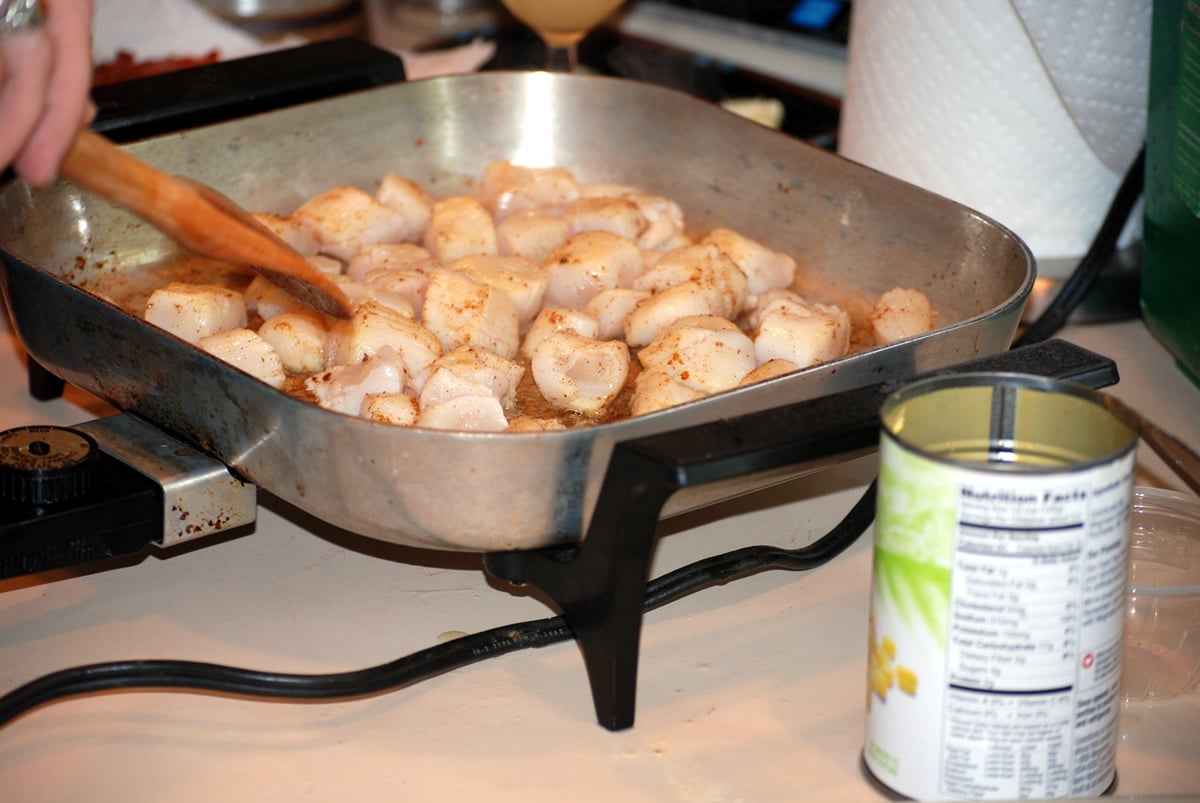
Stir Frying Scallops
Use this method for smaller, sweeter bay scallops.
Heat a wok over high heat. Add a tablespoon of peanut oil.
Add the bay scallops and a couple of teaspoons of soy sauce. Keep the scallops moving and cook until opaque, about two to three minutes.
Of course, you may stir fry with vegetables, too. In this case, rather than cooking the scallops first, remove them to cook the vegetables and then add them back in at the end. Cook the vegetables first.
Since the scallops take so little time to cook, you will have no problem keeping the vegetables warm.
What About Stews and Risottos?
The techniques above are all for cooking scallops when they will be the main event. What about when scallops are just one ingredient and are only added for an accent, as in a cioppino (fish stew) or a risotto?
Yes, it might take almost half an hour to make a risotto and even longer to assemble a good fish stew, but “quickly” is still the answer regarding how to cook scallops.
The simplest option is to add the raw scallops to your dish during the last three or four minutes of cooking and then serve. This is what I would recommend.
If you want your scallops to be a little darker, you can either stir fry or sear them for a minute or so and then add them to your hot dish after it has already come off the stove, allowing the heat of your stew or risotto to finish cooking them.
Because scallops cook quickly and can overcook even more quickly, they do not reheat well. So either make just enough of a dish to serve everyone with no leftovers or expect to have some chewy scallops the next day.
I have seen some recipes for scallop casseroles that go against the “quick cooking” rule. Most of these casseroles contain a lot of fat, such as heavy cream or canned cream soup.
Adding so much creamy fat can help prevent the scallops from tasting overcooked, so, as with most rules, fat-filled casseroles are the exception.
Scallops – How to Cook Scallops
Ingredients
- 1½ pounds bay scallops
- ½ pound sliced mushrooms
- 1 tablespoon butter
- 2 sprigs fresh thyme
- pinch kosher salt and freshly ground black pepper
- ¼ cup dry white wine
- 4 oz cheddar cheese mild, grated
- 4 tablespoons butter
- 4 tablespoons flour
- ½ teaspoon salt
- 2 cups whole milk
- 1 teaspoon Old Bay seasoning
- several strips of bacon
Instructions
- Place the scallops in a buttered 1½ quart casserole dish.
- Sauté the mushrooms in 1 tablespoon of butter along with the fresh thyme, pinch of salt, and pepper.
- Add the white wine, and continue to cook until all the liquid is evaporated. Set aside to cool.
- Remove the thyme stems, and then spread them over the scallops.
- Heat 4 tablespoons of butter in a heavy-bottomed saucepan until melted and bubbly.
- Add the flour and salt and cook, constantly stirring, for two minutes.
- Add the milk all at once and stir until the mixture comes to a boil. Reduce the heat to medium-low and simmer until thickened.
- Add the Old Bay seasoning.
- Stir in the cheese a little at a time off the heat. Taste and adjust seasonings as necessary.
- Pour the sauce over the scallops and mushrooms.
- Cover with strips of bacon, and bake at 350°F for about thirty minutes.
- Let cool slightly before serving.

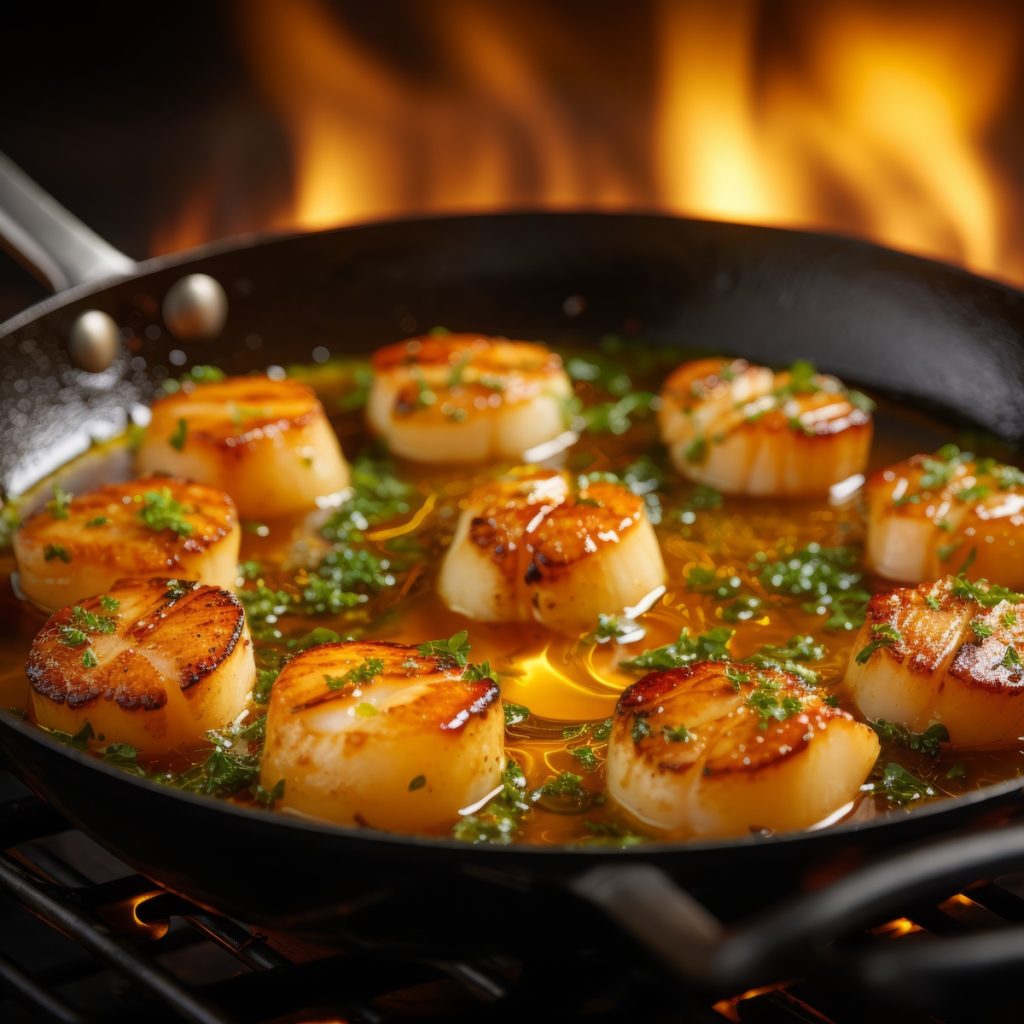




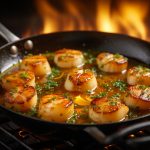
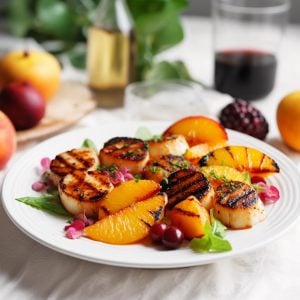
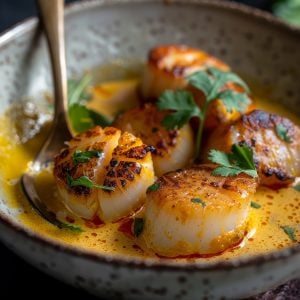
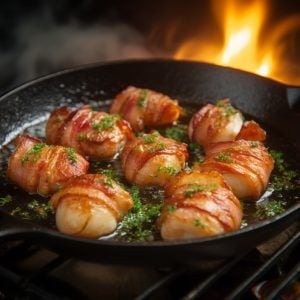
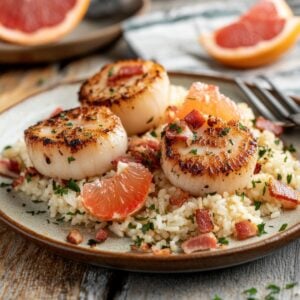
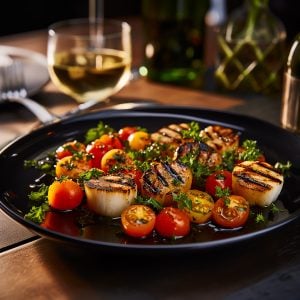
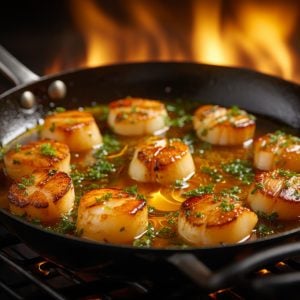


31 Responses
Hi,
I agree with everything above, although I think it is worth pointing out that no salt goes onto the scallops until they are done cooking. The salt will draw out liquid, which inhibits the caramelization, and the next thing you know, you have steamed scallops. Also, the process of removing the side muscle (aka foot) is most easily done by just pulling them off by hand. No knife needed.
Bjorn
Absolutely no salt nor pepper till done. Johnson & Wales Culinary major. The salt draws the moisture out inhibiting maillard reaction and the pepper can burn making a bitter taste. No moving them while searing and clarified butter is the best fat to use. New Bedford fisherman eat at our restaurant and they know their scallops. You really don’t even need salt as they have a oceany brine taste…just a pinch after maybe with pepper if you like. Drawn butter and lemon are popular, the fried scallops are much more popular. We get some the size of baseballs, even here in New Bedford those fetch 25 bucks per lb!
Most baseball sized are flown to Japan that same day.
Hi Bjorn, thanks for the tips and comments. I’m aware that salt does draw out liquids in foods but I’m not sure I agree that you shouldn’t season the scallops before cooking. Almost every cookbook I’ve looked at say to season them first but they don’t say why. I’m going to research this and learn more about the pros and cons of seasoning foods in general before cooking. Thanks for bringing this point up. – RG
5/26/11 Followup – Hi Bjorn, I did a little research and can now say I don’t agree you shouldn’t salt scallops before cooking. In fact, I plan to write a post about when to salt foods in general. There’s a lot of information on the Internet about salting foods before you cook but not much on why so I went immediately to Harold McGee’s On Food and Cooking. About presalting fish and shrimp before cooking, he says, “Japanese cooks briefly presalt most fish and shrimp to remove surface moisture and odor and firm the outer layers. This is especially useful for getting fish skin to crisp and brown quickly when fried.”
I then called a chef friend and asked him about salting scallops before cooking and he said if you dry the scallops first and make sure your pan is at the right temperature, very little liquid will escape and the scallops cook so fast, you don’t need to worry about them drying out when presalted. Overcooking, he said, is another thing. – RG
We use a similar recipe to your casserole but include shallots and dried mint, which is sometimes augmented with a touch of dried fenugreek too. Try it for yourself, we think it’s nice.
fenugreek is so weird, I only had success using it in a Curry, it’s bitter sweet caramel maplely strange taste turns off a lot of folks and a little goes a long way. I think the Greeks use it quite a bit as the Indians.
I stand corrected. As it happens, my wife had bought a pound of large local scallops today, so it was time to do a (somewhat) controlled experiment. I seasoned half of them with salt and pepper and only applied pepper to the other half. I cooked them in two separate (but equal) pans, and it is fair to say that the pre-seasoned scallops browned just as nicely as the ones that were only peppered. Tasting both of them once fully cooked and seasoned, I don’t think there was a big difference in either taste or texture, so the downside of delaying the salting is fairly limited (for what that is worth). Thinking back to the origin of my (errant) belief on this topic, my guess is that it is a mixture of having encountered STP treated scallops, which are liable to drain a lot of liquids into the pan either way, and somewhat unrelated issues with sauteeing mushrooms, which definitely have issues with prematurely releasing liquid if salted. Thanks for doing the research on this topic.
You are very welcome Bjorn – RG
RG- Thank you so much!!! You are just in time. Scallops go on sale at Whole Foods this Friday for only $9.99!! I have printed your post and cannot wait to practice. I just cannot say enough about how well you write your articles. I really feel like I have an instructor right beside me explaining the product and walking me through, step-by-step, on how to properly cook an item. Also, have to add that when you explain a product to readers as you do, it really elicits a respect for that item. I also want to give a shout to Bjorn for his input.
You are welcome Miss Emerson and thank you for your kind words. Much appreciated. – RG
Great informative article! Thanks for sharing your tips – I adore Scallops!
Thank you for that. Now I feel a little more confident to try the larger ones. i use the little bay scallops and bay shrimp in my risottos, adding them in during the last application of stock. They come out perfect!! Thanks again.
You are very welcome Allyson – RG
you need to write some recipes on just scallops nothing else just a recipe that has like a special sauce or something
thank you and please get some recipes on !!!!
Although I came upon this site a few hours too late, I will surely remember the tips the next time I cook scallops.
Thanks!
I just cooked scallops this evening I did not use salt or pepper. I used a egg & milk mixture with o’bay seasoning , dip scallops in that and cover with flour throw in skillet of course with oil & fry it like chicken… mmm. good.. quick & si mple..
Hi Yr picture of scallops looks delicious, not like some I had today which were panko coated. When I looked inside, the supposed scallop was peeling apart in layers, like some thin layer of jelly crap that had been rolled and then cut into medallions to resemble scallops. I told the server I do not think this is really ascallop. She said Oh that is the texture of the cooked scallop. A more ferocious person would have made a big scene but I said thank you, paid and will never go again based on the stinky taste anyway. I bet you have never seen scallops that peel apart in distinct layers once cooked. What do you think, could she be right and they just tasted like crap but were really scallops? Thanks for yr nice blog. JB
Cooked scallops should naturally separate into layers or “flakes” when gently pulled apart. This is due to their muscle fiber structure, which is made up of tightly packed strands that run in one direction. Scallops remain tender when properly cooked and flake easily with slight pressure. It sounds like they were not prepared properly.
perfect. thank you.
Just found your website and want to thank you! I love it when folk are kind enough to share their experience for the good of others. Christmas will be early this year as my adult offspring are coming to us next Saturday. It will be our last Christmas here as we are down-sizing in 2014…. Scallops will be on the menu 🙂 happy Christmas!
You are very welcome Tricia from England and Merry Christmas to you and your family.
Bay scallops…some people online say they are sweeter. I have never ever tasted any that were even half as sweet or tasty as Sea Scallops. We didn’t spend much time on scallops in cooking school so maybe I am buying the wrong kind..the ones they sell here are called Chesapeake Bay scallops and I don’t really like them that much, they are a lot cheaper though. They sell some in the Asian market frozen still in the shell right next to something called “Giant Water bug”, which looks like a giant roach, needless to say I have never tried neither.
Cape Cod Bay scallops are the sweetest scallops in the world, with folks from Nantucket saying theirs are the best. But with only 15 miles separating the two, it’s just a local rivalry. Anyways, Cape Cod bay scallops are sweet like sugar cane and they never leave the Cape. The locals know what they like.
Don’t blame you Bill!!!
Bay scallops are nasty bottom feeder type seafood-gritty and strong fish taste! Fresh SEA scallops are sweet and clean tasting. No salt no pepper EVER until after grilling or pan frying.Forget spices-scallops are very tasty all by themselves.
Use new super coated pans-for grilling use coated skewers so they do not stick and pull apart-forget the ‘olive grease’ and ‘animal fat! Sear or brown till they are just browning around the edges-and the scallops turn ‘white-ish’ and are no longer ‘clear’ looking..
Now for the best way to enjoy scallops in my humble opinion–BAKE THEM! Put a pound of ‘dry’ sea scallops in a baking dish-ladle on cooking sherry to moisten-next cover them with an ample dollop of honey-bake at about 350–checking frequently for ‘color’–same rule here-when they turn white-ish–eat em!
Sounds good Gringo Fisherman. Will have to try baking them sometime soon. Thanks for sharing.
I read the other comments on your site, and simply wanted to give a tip to your readers that we got from a cook at Scoma’s in San Francisco. He suggested we soak the washed scallops in olive oil over night in the fridge before frying. We do it and it tastes great.
Does anyone know whether scallops keep warm well after being cooked, or must they be eaten immediately? Seared in a pan and placed in a warm oven for, say 15, 20 minutes. Would this ruin them? I would greatly appreciate any help.
They would be over cooked if you were to do that. They are best served right away and do not take long at all to cook. Hope this helps
Seared scallops are best eaten immediately because they are delicate and can quickly become overcooked. They will likely become rubbery and dry if placed in the oven for 10 to 20 minutes after searing.
If you need to hold them for a short time, a better approach is to keep them warm in a low-temperature oven (around 175°F/80°C) for no more than a few minutes. Alternatively, you can sear them in advance and finish cooking them just before serving by gently reheating in a warm sauce or butter.
Hey!!! This is so great!! Do you realize this has been going since 2011? I am smelling scallops, and they are delicious!!!!
Yeah!
Hi, I was googling around for the content about the seafood. On this page, I found your fantastic resource. Just wanted to let you know how much your page has helped me. We provide fresh fish, blue crab, crab cake, alaskan crab legs, shrimp, shellfish, seafood soup, and more. Thanks for compiling your resource list and have a great day! – Divya